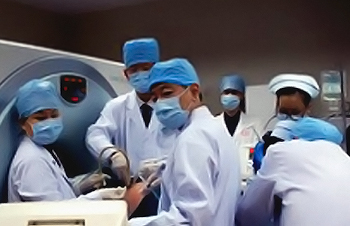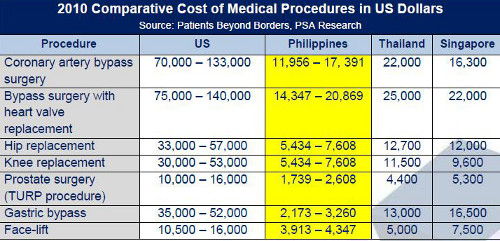The Doctor will see you now
The Philippines, having become a major player in the business process outsourcing, is preparing to take on other countries across Asia in a new field ? medical tourism, a plan that makes sense since the country is a major supplier of medical personnel to the west.
Maybe we get to stay home
In February, Tourism Secretary Ramon Jimenez held a briefing to announce that his department is cooperating with the Department of Health to identify what medical services could be offered. In doing so, Jimenez and other officials are betting into such well-established health providers as Thailand, Singapore, India and Malaysia, hoping to combine access to Filipino beaches as well as hospital services.
There is huge demand for orthodontics or dentistry, cancer and retirement, cataract laser surgery and other medical procedures at costs a fraction of those overseas, Jimenez said, adding that medical services are among the tourism products the Philippine government wants to promote.
Despite well-trained medical staffs and first-rate facilities, the Philippines is well behind other countries in the region in trying to draw health tourists. The government says it is seeking to counter that lag by working on bilateral government-to-government agreements focusing on medical health exchanges and hospital-to-hospital partnerships with foreign institutions as well as working with foreign referral companies and doctors to draw patients,. Its target market is overseas Filipinos in the US and Canada, the Australian market, the island states, Japanese and Koreans, of whom nearly 1 million are already in the country.
Despite the drawbacks, the plan dovetails with a sense that the Philippines is finally getting moving after the years of paralysis from a long series of crooked or ineffective administrations. The government of Benigno S. Aquino III has taken on the Catholic Church and pushed through a birth control program that the church is nonetheless still fighting furiously and has “put in place what we consider its greatest economic achievement, the most sweeping changes in public procurement procedures in the last 50 years, if not longer,” according to a report on the country by the Hong Kong-based Asianomics financial analysis firm. ” This anti-corruption, anti-graft focus has transformed public expenditure in the Philippines, as well as the participation in the procurement bidding process by some of the most efficient and cleanest companies in the country.”
The competition for health dollars is keen. Given the cost of health care in the advanced countries, more than 50 countries across the planet have identified various forms of health tourism as a national industry, unfortunately with widely varying standards of accreditation and health quality. It is a lucrative field, both for health care and tourism as many patients combine the two. India and Thailand in the region have been identified particularly as destinations ? Thailand for its beaches and other attractions as much as for its medical care, which is deemed to be first-rate. India has been in the medical tourism game for more than a decade and at last count had welcomed 150,000 people to the country. The industry, growing 30 percent annually is expected to bring in US$2 billion a year by 2015.
Thailand is equally if not more advanced than India, particularly in cosmetic surgery including nose jobs and breast augmentations. One hospital alone took in 150,000 patients in 2006 and the industry has grown rapidly since.
Prospective patients are usually seeking elective surgeries including joint replacement such s hips or knees, prostate surgery or coronary bypasses (see chart). The Philippines is strongly competitive in most of these, with dramatic differences in cost with the United States, the world’s most expensive place for medical care, far above at the top of the list.
Source: PSA
GRAPH
The campaign to attract medical tourists “comes at a time when Filipino doctors and medical facilities are gaining greater recognition for providing health care services that are on par with international standards, according to a report by Pacific Strategies and Assessments, a country risk firm headquartered in Manila. Many of the basic components needed to expand medical tourism are already thus in place. The Philippines, according to the PSA report, “boasts several state-of-the-art medical centers that provide advanced medical procedures such as stem-cell therapy by western-educated Filipino doctors.”
The drawbacks, according to the PSA report, are rooted in many problems that traditionally have plagued the Philippines; shambolic infrastructure, a hostile climate to foreign investment, a rigid labor structure and inability to put in place government policy to accommodate western interests. Medical centers in India, Thailand and Singapore in particular have lucrative partnerships with international insurance companies that find it in their interest to act as clearing houses for the treatment of policyholders, allowing them to save significant amounts of money for payouts to medical providers.
In the Philippines, however, “Partly due to the country’s lack of accreditation with larger insurers, experts on medical tourism say that the dearth of international private insurance in the Philippines is intentionally designed to protect the local insurance industry.” That puts roadblocks in the way of international insurance companies trying to save money on medical care, and denies the Philippines a lucrative and relatively prestigious source of income as well as populating its beaches with foreigners recuperating from their nose jobs and breast implants and eager to show them off.
The other problem is that while the Philippines trains vast numbers of doctors and nurses, they often depart for the west, where salaries are so much better than an individual trained as a physician at a Filipino medical school can make more money as a nurse in the United States than he can as a doctor in his own country. The hospitals in the United States, particularly in California, are filled with huge numbers of Filipino medical personnel, not to mention Indians and residents of many other countries. A prosperous medical industry in the Philippines would go a long way toward keeping its diaspora at home.
source: http://www.asiasentinel.com / Home> Economics/Business> Philippines / by Asia Sentinel’s Correspondent / Wednesday, March 13th, 2013



